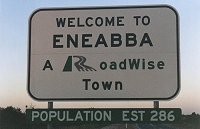


| History |
| In 1837
Lieutenant Grey carried out an investigation of the West Coast. He
was forced to travel by land after he lost his boats and as he passed
through Eneabba area he named the Arrowsmith River. The area was settled
around 1870 and according to the old story the settlers shepherded,
trapped horses, pigs, dingoes and lived on wild game. . Private settlers made very little progress in Eneabba until the Government moved in with the War Service Land Settlement Scheme. The Settlers were chosen because they were considered to be knowledgeable in farming and each was given a farm of 3300 acres valued at $42,000 on 1947-48 purchasing power, a two-bedroom house and stock and car allowance. A school was opened in 1960 in the appropriate building - machinery shed. Attendance on the first day was nil (?). [A correction from John who actually was at the school on the first day - by his guess the attendance was about 20...] . Mining in the area started in mid-seventies by 5 mining companies. Two of them decided to use the townsite of Eneabba, which was situated closer to their mining leases, two more opted for Leeman on the coast. A great consideration was given to the planning of the town at the time in order to avoid creation of a potential rural slum. The idea was to make a variety of recreational activities available to residents who will be able to mix with people other than their immediate workmates - unlike the mining towns of the Northwest. The houses were constructed in Perth and transported to Eneabba, their design considered to be one of the best at that time. |
|
Mining and agriculture |
| Titanium
pigment produced from rutile and ilmenite mined in the area valued
as one of the most economical and non-toxic white pigments on earth
and is used in paints, paper, plastics, toothpaste and cosmetics,
titanium alloys - in the aircraft and airspace industries. Zircon
- another product - is the most common opacifier in ceramics and tiles.
Agriculture is another major activity in the area with wool, crops
and environmentally clean cattle being the main produce. It became
apparent over time that the mining and farming complement each other
to make for a very solid little town to be proud of. |
|
Nature and Climate |
| The native vegetation
is known as Kwongan,
an aboriginal term for low hard scrub. Kwongan heathland of the Eneabba
region is extremely diverse and contains many species, which are endemic
to the region, thus accounting for it being recognized by tourists
and botanists as an area of interest and part of the route of the
Northern wildflower tours. A few species are known to occur only in
this area: Calytrix superba - south of Eneabba, Banksia
elegans - near Lake Indoon, Verticordia affinity nitens
- in several locations. 41 species are considered to be rare or threatened,
the most famous is Hidden Beard Heath (Leucopogon obtectus).
DEC (Department of Environment Conservation) maintains
records of the plants numbers and locations, and each plant is marked
with the blue flagging tape and a steel picket. Please be very careful
when using tracks in the area - damage to Declared Rare Flora carries
a maximum penalty of $60,000. . There are also 25 species of reptiles, 78 species of birds and 10 species of native mammals. One species is considered to be an unusual or rare find (Sminthopsis or hopping mouse). Blue tongue lizards and mountain thorny devils are quite common sight within the town, kangaroos and emus graze on the playground and around the Community Club in early hours of the morning, black cockatoos are frequently seen in town and echidnas can be spotted near the Eneabba creek at dawn. . Summer temperatures are frequently higher than in neighbouring towns and Eneabba frequently reports the highest temperature in the State during January-February - temperatures in high forties are not uncommon. The World Meteorology Bureau recorded Eneabba as being the hottest place on Earth on one particular day. |
|
Places to see |
| A lot of places of
interest are located within a comfortable driving distance from Eneabba.
Some are well known, such as
Nambung National Park (Pinnacles), Lesueur National Park,
Coalseam National Park,
Lake Indoon, coastal areas,
and Yarra Yarra Lake near
Carnamah. Others are less known, such as
Lake Logue flora and fauna Reserve, Beekeepers Nature Reserve,
and Stockyard Gully Caves. |
|
Facilities |
| Eneabba General Store
and Post Office is open five and a half days a week (until lunchtime
on Saturday). The sport complex includes a golf course, swimming pool,
football/cricket ground, tennis courts and bowling green. The swimming
pool is open from November to April and presents a great opportunity
to have a refreshing dip while on the long haul from Perth to Geraldton
and beyond. Dining is available at Sands Tavern and Shell Roadhouse. |